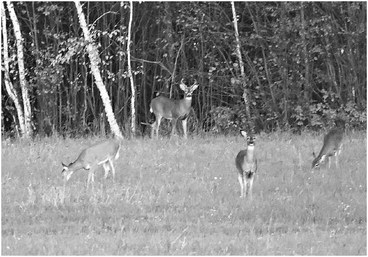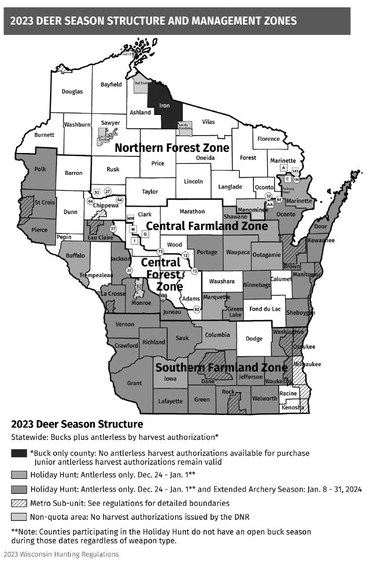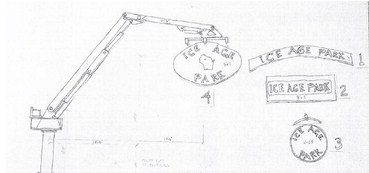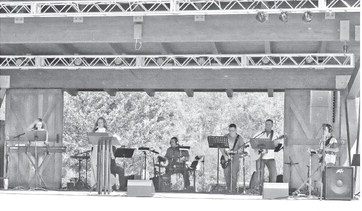Gun deer season outlook


BY MATT FREY
THE STAR NEWS
The flip of the calendar from October to November certainly is meaningful to most of Wisconsin’s white-tailed deer hunters.
For those who have not gotten their shot at a buck yet this fall with archery equipment or a crossbow, the early part of the month likely served as their best chances to bag a big one as the deer’s mating season, the rut, kicked into high gear.
Then, of course, there is the annual nine-day gun hunting season, which begins next Saturday, Nov. 18 and runs through Nov. 26 and will lure several hundred thousand Wisconsin hunters into the woods, fields and marshes at one point or another and reunite friends and family at time-honored hunting camps.
So far this fall, at least in the local four-county area of Taylor, Clark, Chippewa and Marathon counties, hunters were harvesting deer at a slower place through the end of October than they were in 2022. The numbers, as reported on the Department of Natural Resources’ harvest data website, did seem to spike upward in the last few days of October, likely signifying the rut –– and possibly higher hunter effort –– had kicked in.
Wisconsin DNR wildlife personnel expected deer populations to be strong and healthy for the most part coming into the fall. How strong the numbers are, of course, depends on the area and habitat you hunt. While the snowpack lingered into April, temperatures weren’t overly cold in that time, minimizing any winter effects on vulnerable deer. In the West Central District, which includes Clark, Chippewa and Marathon counties, the snow melted quickly and green-up was in full effect by May.
Taylor County is in the Northern Forest region, which can be more susceptible to winter severity, but the hardest-hit areas of the region were well north of the county.
“There is lots of food available this fall especially,” said Emma Hansen, the DNR’s wildlife biologist for Taylor and Rusk counties. “That, I think, helped them catch up from last winter. We had a long winter, but we didn’t have a lot of cold days. This year it was drawn-out but we didn’t have the cold. We had a winter severity index in Taylor County of 41 and that’s still in the mild category. There were pockets, and when you think of the Chequamegon-Nicolet National National Forest deep in the interior of the woods, there’s not as much food available in those settings so they might have been hit a little harder in areas like that. The dry spring might have been really good for little fawns to keep warm and grow. Now this fall that we have a lot of natural food on the landscape we have a completely healthy deer herd on the landscape for this year’s hunting season.”
Weather always plays a factor in how the harvest during a nine-day gun season compares to seasons past. One factor that could play into hunters’ favor is the Nov. 18 start, the second-earliest date possible under Wisconsin’s season format. That may increase the odds slightly for good weather on opening weekend and increase the odds that the rut won’t be completely over.
“We’ll be closer to the peak of the rut,” Hansen said. “Of course, gun deer season doesn’t really overlap with the peak. That’s usually the last week of October, early November, somewhere around there. But we definitely should see some trickling effects of that.”
Next year, due to leap year, the start date will revert back to the latest start date possible, Nov. 23.
After the nine-day hunt ends, hunting options include the muzzleloader season Nov. 27-Dec. 6, the statewide antlerlessonly hunt Dec. 7-10, holiday antlerless hunts Dec. 24-Jan. 1 in many deer management units, especially in the southern half of the state and the archery/crossbow season, which extends to Jan. 7, 2024 in most units. The bow season does go through Jan. 31 in some of the state’s most heavily-populated units.
Here is a forecast synopsis for the four-county Central Wisconsin News coverage area.
Taylor County
The 2023 deer hunt seems to be off to a slow start in Taylor County, but the hope is that the harvest will pick up in November with the rut hitting its peak and, hopefully, good weather for the early Nov. 18 start to the nine-day gun deer season.
“It’s been slow,” the county’s DNR wildlife biologist Emma Hansen said in an Oct. 26 interview. “So far this year we’ve had warm weather and it seems like on a lot of weekends we’ve had rain so that not only limits deer movement, but people aren’t out there either hunting. We’re definitely down. At this time of the year we’re a little lower than our five-year average for where we’re normally at this time of year.
“That can always change depending on the conditions during gun deer season,” she added. “We’ve been in situations in the past where it’s been pretty slow but you get those great opening days with a fresh blanket of snow, it’s 20-30 degrees out and that can really make an impact and shoot your harvests up above average. Really we’re still waiting to see how things shape up overall, just depending on how things look in the gun deer season.”
Through Oct. 30, crossbow hunters had registered 374 deer, including 202 bucks and 172 antlerless deer, while archery hunters had stuck an additional 155 with 68 of them being bucks and 87 being antlerless. At this point a year ago, crossbow hunters had registered 583 deer and archery hunters had bagged 263.
Harvest numbers aside, Hansen said the herd in the county should be healthy and deer numbers, in general, are strong.
As the southernmost county in the DNR’s Northern Forest region, there should have been little winter impact on the herd. There was some concern about the long winter when the county’s Deer Advisory Council met in May and reduced antlerless permit levels slightly. The 8,520 private land tags aren’t likely to sell out (3,250 remained as of Nov. 1), while the 595 public tags were gone within a matter of a few hours, as usual. As it turned it, the county’s winter severity index was only 41, almost entirely due to snow cover, which still fell in the mild category.
“One of the challenges is we have public land scattered throughout the county,” Hansen said. “The Managed Forest Law Open properties are also considered public land and those are scattered quite a bit within the private land. So it can be challenging trying to manage a deer herd when those private and public land tags are mixed in with each other. A fairly significant portion of the county is in the Chequamegon-Nicolet National Forest.
Those areas that are primarily forest, especially in the interior parts, they naturally don’t have as much food available. It’s normal to not have as high deer densities in those places as you would at the edge of ag areas or where you have a mix of forest land and crop land.
“In Taylor County we have such a var-



